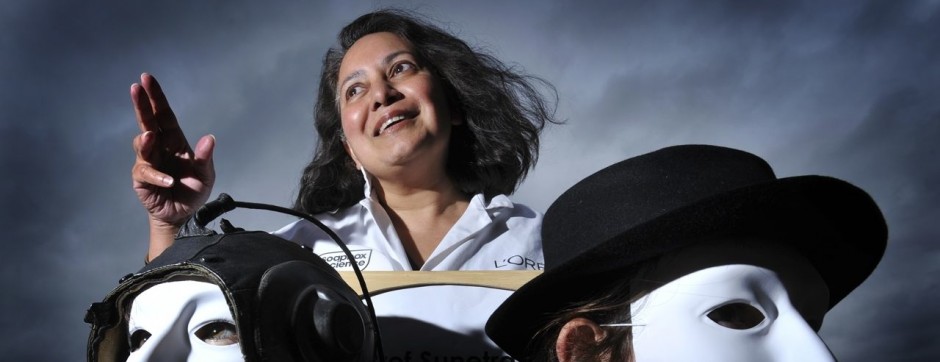 Rosie Johnson is a PhD student in space plasma physics at the Department of Physics and Astronomy, University of Leicester. The focus of her research is the infrared aurora of Jupiter. Here, Rosie tells us how she went from studying the Earth’s aurora from the cold Northern island of Svalbard to observing Jupiter’s aurora from the top of a volcano in Hawai’i; and how it is important to break stereotypes and make women in STEM ‘unsurprising’.
Rosie Johnson is a PhD student in space plasma physics at the Department of Physics and Astronomy, University of Leicester. The focus of her research is the infrared aurora of Jupiter. Here, Rosie tells us how she went from studying the Earth’s aurora from the cold Northern island of Svalbard to observing Jupiter’s aurora from the top of a volcano in Hawai’i; and how it is important to break stereotypes and make women in STEM ‘unsurprising’.
Catch Rosie on her soapbox Saturday 9th July, in Milton Keynes, where she’ll be talking about ‘The Aurora: from Earth to the gas giants and beyond…’
SS: Rosie, how did you get to your current position?
RJ: I completed my undergraduate Master’s degree in Physics with Planetary and Space Physics at Aberystwyth University. My favorite lectures were about the planets, especially their atmospheres. For my third year dissertation, I studied Saturn and I loved learning about the icy, volatile moon Enceladus, which has active water geysers. In the second semester of my fourth year I had the amazing opportunity to study at UNIS, Svalbard, which is situated inside the arctic circle at 78 degrees North. It was incredible to not only study to aurora, but to witness it firsthand! After my time in Svalbard I was successful in securing a project at the University of Leicester to study Jupiter’s aurora. I am now in my second year of studying for a PhD, the focus of which is the infra-red aurora of Jupiter. I use a combination of spectroscopy and the principal of Doppler shift to calculate the velocity of the charged molecules in Jupiter upper atmosphere, which create part of Jupiter’s infrared aurora, and this reveals the dynamics of Jupiter’s magnetic environment.
SS: What, or who, inspired you to get a career in science?
RJ: For some reason it seemed natural to me that if I were to go to university to study, I would take it all the way to PhD level. Perhaps this was because my Dad has a PhD and maybe I chose physics because he was a physics lecturer. Growing up my Mum always made it very clear that girls can do whatever they want and this was reinforced by my fantastic physics teacher Mrs Hill. During my A levels I attended Space School UK which is a week-long residential summer school, hosted by the University of Leicester. I think being at this summer school, along with other boys and girls who were passionate about physics gave me the confidence to study physics at university. During my undergraduate years several things inspired me to get a career in science: I guess it was no coincidence that that my favourite subject of planetary science was taught by my favourite lecturers and my experiences in Svalbard definitely were key in my decision to study the aurora for my PhD. Even though I’ve always had a strong interest in science I think it’s the people I’ve met along the way that really encouraged me to get a career in science.
SS: What is the most fascinating aspect of your research/work?
RJ: The most fascinating part of my research is the data collection. I’m really lucky to have visited the Mauna Kea Observatories in Hawai’i twice now and the second time as the Primary Investigator (PI). We observe Jupiter’s aurora using the NASA Infra-Red Telescope Facility (IRTF). Jupiter is a fantastic object to observe; even when I’m not taking images and doing spectroscopy, the raw data looks pretty cool. The best thing about infrared is I can choose the colour table, so I usually go for the most garish and fun colours, turning Jupiter’s aurora green and pink! I think it’s great to be able to collect your own data and experience the more practical side to astronomy.
SS: What attracted you to Soapbox Science in the first place?
RJ: I like that Soapbox Science engages with members of the public that may not be particularly interested in STEM subjects. By breaking down the stereotypes of what people usually think of when they imagine a scientist, Soapbox Science can show how STEM subjects are for everyone!
SS; Sum up in one word your expectations for the day – excitement? Fear? Thrill? Anticipation?
RJ: Nervcitement – a strong combination of nervousness and excitement!
SS: If you could change one thing about the scientific culture right now, what would it be?
RJ: I would redefine the word normal so that nobody has to be surprised when it turns out a scientist is female. Even if women aren’t common in STEM, it’s definitely a normal thing for us to want to be here and to love science – we’re really not that surprising!
SS: What would be your top recommendation to a female PhD student considering pursuing a career in academia?
RJ: Find out what imposter syndrome is early on in your PhD and fight it! 🙂
